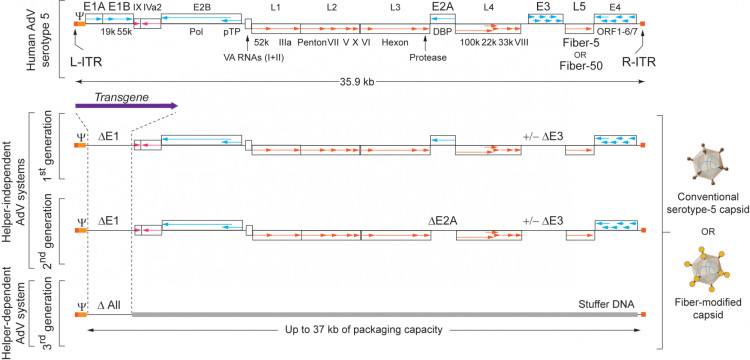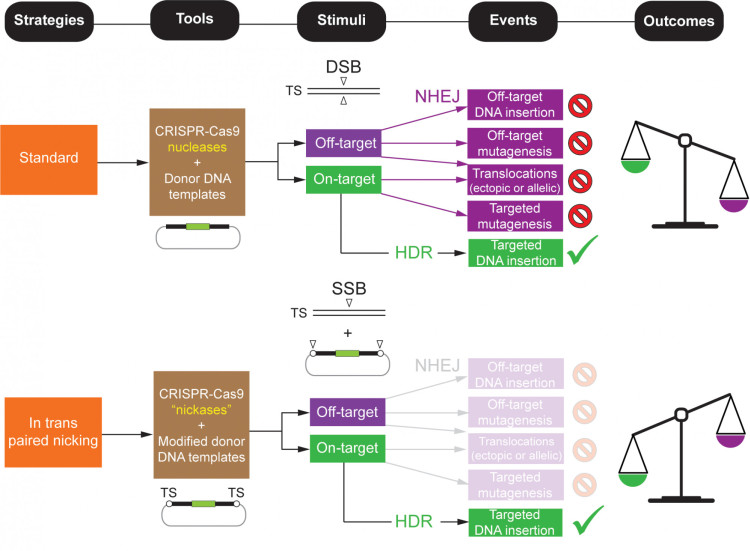Targeted double-stranded DNA break (DSB)-induced genome editing permits changing specific DNA sequences in living cells, ideally, without collateral chromosomal mutations or rearrangements. The delivery of programmable nucleases alone or together with donor DNA templates can yield gene knockouts and gene knock-ins mainly through the recruitment of the non-homologous end joining (NHEJ) and homology-directed DNA repair (HDR) pathways, respectively. There are, however, many crucial aspects linked to DNA editing processes that, clearly, require further investigation and refinement. In this regard, we focus on three interconnected research lines that build upon viral vector and gene editing technologies and whose goals are.
(1) Improving the delivery of programmable nucleases and donor DNA templates into human cells.
The sizable packaging capacity of adenoviral vectors (AdVs), combined with their strict episomal nature, high-titers and efficient transduction of dividing and non-dividing cells, offers an attractive set of features worth exploring for genome editing purposes. Hence, we focus on testing the feasibility and utility of using conventional and capsid-modified adenoviral vectors (AdVs) for introducing into the nuclei of target cells donor DNA substrates and/or programmable DNA editing machineries (e.g., nuclease and nickase complexes, including base editors and prime editors). To this end, we construct and test latest-generation adenovector particles whose tropism has been modified to permit efficient ex vivo transduction of therapeutically relevant human cells, e.g., hematopoietic stem cells and muscle progenitor cells (Figure 1). Importantly, the production of these viral gene-free vector particles takes place in GLP-grade complementing packaging cell lines designed to prevent the emergence of replication-competent adenoviruses (RCAs).
(2) Studying the impact of epigenetic processes on the performance of genome editing tools and strategies.
Once inside cell nuclei, the aforementioned genome-editing reagents have to contend with target sequences embedded in epigenetically regulated higher-order chromatin structures. In this regard, knowing the influence of alternative chromatin states (e.g. “open” euchromatin versus “closed” heterochromatin), on the performance of genome-editing tools per se and genome-editing strategies as whole, is important. To this end, we have implemented quantitative cellular systems in which the euchromatic and heterochromatic statuses of isogenic target sequences are stringently controlled by small-molecule drug availability. These cell-based reporter systems, permit screening and selecting genome-editing reagents from different platforms or with specific architectures and compositions. In addition, these live-cell readout systems are valuable for assessing the genome-editing endpoints, e.g., the balance between HDR and NHEJ events resulting from the interaction between alternative chromatin conformations and different donor DNA structures (e.g. single-stranded oligonucleotides versus double-stranded plasmids).
(3) Improving the specificity and accuracy of genome editing procedures.
A shortcoming of HDR-based genome editing is the fact that DSB repair often occurs through the competing and mutagenic NHEJ pathway. As a result, allelic mutations, translocations, and other unwarranted structural variations caused by on-target and off-target DSBs, are common. Furthermore, NHEJ also contributes to random and imprecise chromosomal insertion of the donor DNA. To address these issues, we are investigating the feasibility and utility of using CRISPR-Cas9 “nickases” that generate single-stranded DNA breaks (SSBs). In contrast to DSBs, SSBs (or nicks) are not substrates for NHEJ while they are still capable of stimulating HDR, albeit at low efficiency. Importantly, our research has shown that coordinated SSB formation at target and donor DNA templates (in trans paired nicking) yields efficient, precise and non-mutagenic genome editing in human cells, including pluripotent stem cells. We are hence further exploring this strategy and its underlying mechanisms (Figure 2). Next to this, we investigate the performance of different donor DNA substrates (e.g. linear, circular and protein-capped) in bringing about targeted and accurate exogenous DNA knock-ins.
Ultimately, the tools and insights obtained through our research activities are directed towards establishing disease-in-a-dish models and developing genetic therapies for diseases affecting the striated musculature and hematopoietic systems.

Figure 1. Diagram of adenoviral vector systems. L-ITR and R-ITR, “left” and “right” inverted terminal repeats harboring the viral origins of replication; Y, packaging signal. The early (E) and late (L) regions are expressed before and after the onset of viral DNA replication, respectively. First-generation AdVs lack E1A-E1B or E1A-E1B plus E3. Second-generation AdVs have deletions in additional early regions (e.g., E2A and/or E4) being, as a result, produced in their respective complementing cell lines. Third-generation high-capacity AdVs lack all viral DNA sequences except for the non-coding cis-acting elements ITR and Y. Adapted from: Chen and Gonçalves. Engineered viruses as genome editing devices. Mol. Ther. 24, 447-457 (2016).

Figure 2. Comparing standard versus in trans paired nicking genome editing. The relative weights of wanted and unwanted genome editing outcomes resulting from HDR and NHEJ events, respectively, are illustrated. TS, target site; DSB and SSB, double-stranded and single-stranded DNA breaks, respectively; “nickases”, sequence- and strand-specific nucleases. Adapted from: Maggio and Gonçalves. Genome editing at the crossroads of delivery, specificity, and fidelity. Trends Biotechnol. 33, 280-291 (2015).


